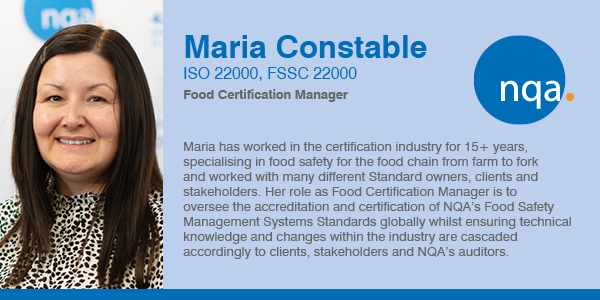Food Safety: ISO 22000 Deadline - 6 Months to Go
Use the self-assessment GAP analysis tool
Our ISO 22000:2018 Transition Gap Guide has been designed to help you to conduct an internal gap analysis against the new Standard clauses which will enable you to identify which of the requirements you already meet and which may need a little work.
You can download the guidance document here.
During your audit, your assessor will want to review your gap analysis. They do this because it will help them determine how well you understand and have implemented the new requirements.
Which requirements seem to be causing the most issues?
We have noticed that there seem to be a few clauses within the Standard that are proving to be a little trickier for organizations to translate to their own management systems...
4 – Context of the Organisation
Determining the scope:
Along with intended use, you need to be able to identify and document what the organisation actually does, or produces. This should not be complicated or a grey area! E.g. processing of fish, this could mean many different things such as:
-
Filleting of fish
-
Canning of fish
-
Smoking
-
Freezing
5 - Leadership:
Under leadership, in food we are also looking at food safety culture. It is proved that with lack of leadership commitment that food safety culture is often low. Where food safety culture is low there are often more avoidable food safety incidents. Your auditor will want to know that senior leadership are involved with the management system and will want to speak to them during their assessment to review their level of understanding and participation.
6 - Planning:
Risks & Opportunities, Internal & External Issues (4.1)
Covid is a perfect example. If the above has been reviewed within the last 12 months (which it should have been!) I doubt that any organization around the world would NOT have Covid on their list! Whether it be a risk, opportunity, internal or external issue. You need to demonstrate to your auditor that you have planned for potential threats and issues that may arise in the future.
6.2 Food Safety Objectives:
Your objectives need to be relevant, measurable, monitored, communicated and maintained. We often see objectives such as “to be the best” or “to be the biggest exporter of XX in the country”. When planning on how to achieve your objectives, you need to consider the following:
-
What you will do?
-
Who will do it?
-
Who will be responsible for it?
-
When it will be completed?
-
How you will monitor and measure its progress?
8 - Operation:
8.2 - When establishing PRP’s, the applicable part of ISO/TS22002 series should be considered.
-
Part 1 – Food Manufacturing
-
Part 2 – Catering
-
Part 3 – Farming
-
Part 4 – Food Packaging
-
Part 5 – Transport & Storage
-
Part 6 – Feed and Animal Feed
7.1.5 - Externally developed elements of the FSMS – remember to include all externally provided processes, products and services (pest control, calibration, testing etc).
10.1 - Non-conformity and corrective action – Do you have a process in place to record, evaluate and learn from any non-conformities? This is not only relating to non-conforming products and will help you to achieve continual improvement.
With ISO 22000 now fully aligned to Annex SL, it makes it easier to integrate it with other ISO Standards such as ISO 9001 (Quality), ISO 14001 (Environmental) or ISO 45001 (Health and Safety). The updated 2018 Standard allows organizations to make decisions on how best to meet the requirements of the Standard based on risk based thinking and incorporates PDCA. This is a huge step towards continual improvement.

